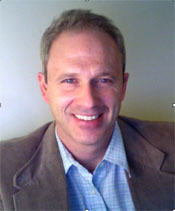neuroplex
New York Association of Neuropathologists
Peter D. Canoll, M.D., Ph.D. |
|||
|---|---|---|---|
Associate Professor of Pathology and Cell Biology |
Phone: 212-851-4632 |
Research Summary
Diffusely infiltrating gliomas, including glioblastomas, astrocytomas, and oligodendrogliomas, are the most common type of adult brain tumors. Which cell types give rise to gliomas is not clear and identifying the 'cells of origin' remains a major goal of brain tumor research. To address this question, we have chosen to focus on the population of progenitors cells that reside in the adult white matter. The subcortical white matter is the largest region of the human forebrain and the most common location in which gliomas arise. Previous studies have shown that approximately 2% of the total cells in the adult rat white matter are cycling progenitors. In humans the number may be as high as 4%. Thus, white matter contains one of the largest pools of proliferating cells in the adult brain. Normally, these cells are slowly proliferating and non-migratory. However, when these cells are stimulated with certain growth factors, such as PDGF, they acquire a more proliferative and migratory phenotype that resembles glioma cells. Also, human gliomas express a number of proteins that are normally expressed by adult white matter progenitors, such as Olig2, NG2 and PDGFR⎕, suggesting they are closely related.
We have developed an experimental glioma model that uses a retrovirus to deliver PDGF and fluorescent reporter genes into adult rat white matter. Tumors that closely resemble human glioblastomas form in 100% of the animals injected. Remarkably, the tumors are composed of a mixture of progenitors infected with the PDGF retrovirus and non-infected progenitors that have been recruited via paracrine growth factor signaling. Both cell populations look and behave like malignant glioma cells. However, when the recruited progenitors are removed from the mitogenic environment they stop proliferating and differentiate. These findings raise several important questions about the relationship between glioma cells and adult progenitors. They also call into question 2 basic doctrines of cancer biology; 1) that tumors are derived from clonal expansion of a single transformed cell and 2) that the malignant behavior requires the accumulation of multiple genetic lesions.
We are using a variety of experimental approaches to study the regulation of glioma cell migration and proliferation and to further investigate interactions between glioma cells and adult progenitor cells in the PDGF model. Our approaches include time-lapse microscopy to monitor migration and proliferation of GFP and DsRed labeled cells in living slices of brain; isolation of progenitor cells and glioma cells from the rodent model and from human tumor specimens using FACS; analysis of proliferation, differentiation, migration and survival in vitro; immunohistochemistry, in situ hybridization and microarray analysis to compare the alterations of gene expression that occur in the PDGF model and those seen in human glioblastomas. In collaboration with the Laboratory of Dr. Jeffery Bruce, we are using the PDGF retrovirus model to test the efficacy of intracerebral delivery of chemotherapeutics.
Selected Publications
- Masui, K., Suzuki,S.O., Torisu, R., Goldman, J.E., Canoll, P., and Iwaki, T., Glial progenitors in the brainstem give rise to malignant gliomas by platelet-derived growth factor stimulation GLIA, In Press (2010)
- David, C., Chen, M., Assanah, M.C., Canoll, P. and Manley, JL., HnRNP proteins controlled by c-Myc deregulate pyruvate kinase mRNA splicing in cancer Nature, 463, 364-368. (2010)
- Sondabend, A.M., Yun, J., Canoll, P. and Bruce, J.N. Glioblastoma Multiforme: Pathophysiology and The Latest Advances in Diagnosis The European Journal of Clinical & Medical Oncology, In Press, (2010).
- Masui, K., Suzuki,S.O., Torisu, R., Goldman, J.E., Canoll, P., and Iwaki, T., Glial progenitors in the brainstem give rise to malignant gliomas by platelet-derived growth factor stimulation GLIA, In Press (2010)
- Assanah MC, Bruce JN, Suzuki SO, Chen A, Goldman JE, Canoll P.. PDGF stimulates the massive expansion of glial progenitors in the neonatal forebrain. Glia. (2009) Dec;57(16):1835-47.
- Ellis JA, Waziri A, Balmaceda C, Canoll P., Bruce JN, Sisti MB. Rapid recurrence and malignant transformation of pilocytic astrocytoma in adult patients. J Neurooncol. (2009) Dec;95(3):377-82. Epub 2009 Jun 17.
- Cayre M, Canoll P., Goldman JE. Cell migration in the normal and pathological postnatal mammalian brain. Prog Neurobiol. (2009) May;88(1):41-63. Epub 2009 Feb 11. Review.
- Bohman LE, Gallardo J, Hankinson TC, Waziri AE, Mandigo CE, McKhann GM 2nd, Sisti MB, Canoll P., Bruce JN. The survival impact of postoperative infection in patients with glioblastoma multiforme. Neurosurgery. (2009) May;64(5):828-34; discussion 834-5.
- Kennedy BC, Maier LM, D'Amico R, Mandigo CE, Fontana EJ, Waziri A, Assanah MC, Canoll P., Anderson RC, Anderson DE, Bruce JN. Dynamics of central and peripheral immunomodulation in a murine glioma model. BMC Immunol. (2009) Feb 18;10:11.
- Canoll P., Goldman JE. The interface between glial progenitors and gliomas. Acta Neuropathol. (2008) Nov;116(5):465-77. Epub 2008 Sep 11. Review.
- Beadle C, Assanah MC, Monzo P, Vallee R, Rosenfeld SS, Canoll P.. The role of myosin II in glioma invasion of the brain. Mol Biol Cell. (2008) Aug;19(8):3357-68. Epub 2008 May 21.
- Waziri A, Killory B, Ogden AT 3rd, Canoll P., Anderson RC, Kent SC, Anderson DE, Bruce JN. Preferential in situ CD4+CD56+ T cell activation and expansion within human glioblastoma. J Immunol. (2008) Jun 1;180(11):7673-80.
Honors and Awards:
- 1996 - Merck Scholar
- 1998 - Award for Distinguished Performance in Research, Associated Medical Schools of New York
- 2001 - Inspiration Award for Pediatric Brain Tumor Research, Children's Brain Tumor Foundation
- 2002 - Sontag Foundation Award for Brain Tumor Research, American Brain Tumor Association
- 2008 - Teacher of the year award for outstanding small group preceptor
- 2009 - Adult Translational Award, Society for Neuro-oncology
Committees , Council, and Professional Society Memberships
- Society for Neuroscience
- Society of Neurooncology
Education and Training
- Sc.B., 1987 Brown University
- Ph.D., 1997 New York University School of Medicine
- M.D., 1998 New York University School of Medicine
